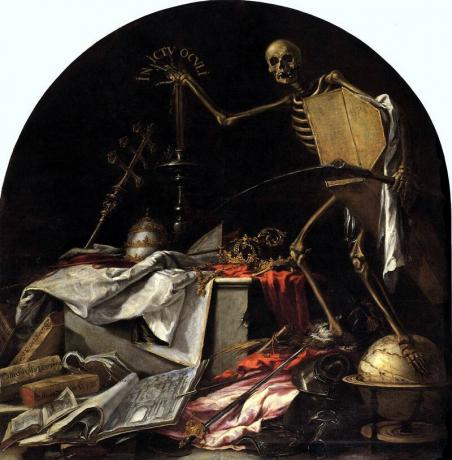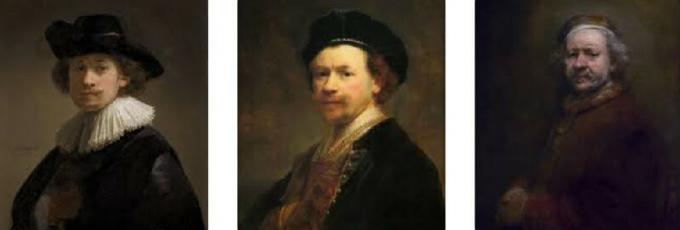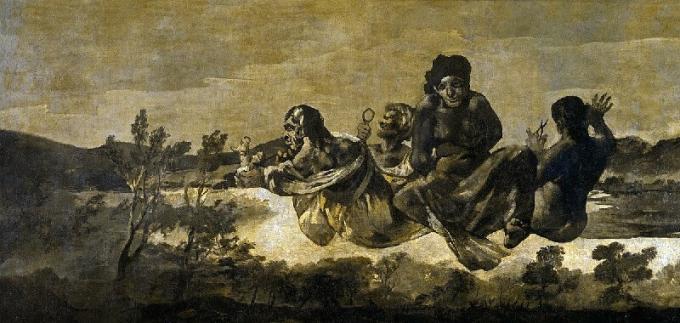10 Works of Art about Time
Tempus fugit, said the Latinos; "time flies". And so it is. Beyond the recent theories of relativity, at all times there has been a concrete concept of time. For the ancients it was something cyclical, which always returned to its starting point; for medieval men and women, it was linear and ended with the second coming of Christ.
For the Baroque era it was the great demolisher of beauty and ephemeral things, hence the great profusion of vanitas (vanities), works where elements were introduced that attested to the passage of time and its relentless destruction. For the 19th century romantics, on the other hand, time was the main constructor of their nostalgia; a nostalgia for the past that translated into a taste for ruins and decadence.
10 famous works of art about time
It is difficult to choose between so many works that talk about the subject of time; this It is a very recurring concept in the history of art.. Below, we present some of the most relevant.
1. mensarial of the Royal Pantheon of San Isidoro de León (s. XI)
The Royal Pantheon of the Kings of León is considered one of the most perfect jewels of Romanesque art on the peninsula. Not surprisingly, it has been called the "Romanesque Sistine Chapel" for its magnificent frescoes, including a high-quality mensarial.
What were the medieval mensaries? These were calendars whose rhythm was marked by the agricultural activities corresponding to each month.. In the case of the mensario of San Isidoro de León, the months are located on the intrados of the arch that is next to the Pantokrator. The month of January includes, as is traditional in these representations, the god Janus, of Roman origin and who marked the beginning of the year. In the month of February, the coldest of all, an old man is represented sheltered from the fire. The month of April, the splendor of spring, is personified by a young man who carries some flowers in his hands, and September is a farmer who collects grapes...

In the Middle Ages, time revolved around God. The medieval Christian time line was finite, since the time of men would end with the second coming of Christ. Parallel to this linear time, there was also another, inherited from antiquity, which saw time as something cyclical, related to changes in nature and the cycles of life.
2. Saturnby Peter Paul Rubens (1636)
You cannot understand time in art without talking about Saturn. This god was an ancient deity from the Italian peninsula that was later assimilated to the Greek god Cronus, from whom he took the attributes. Although Chrono was not the god of time, the resemblance between his name and the Greek name for time has caused an assimilation between the two.
The myth tells that Chrono/Saturn, Fearful of an oracle that had predicted that one of his sons would end up dethroning him, one by one he devoured all the shoots that his wife, Rhea, gave him.. This legend has done nothing but emphasize the god as the personification of time, since time is unstoppable and devours to humans.

Rubens painted this canvas for the Torre de la Parada, in Madrid. In it, he represents Saturn as an old man, although his body is still muscular (after all, he was a Titan), tearing the flesh from his newborn son. The strong theatrical light, so typical of the Baroque, that illuminates both bodies and outlines them against the dark background, gives the scene drama.
- Related article: The 7 Fine Arts"
3. In stroke oculiby Juan de Valdés Leal (1672)
This gloomy canvas, which is among the most famous works of art about time, is paired with the so-called Finis Gloriae Mundi, also by Valdés Leal. Both paintings are in the lower choir of the Hospital de la Caridad in Seville, and were commissioned by the humanist Miguel Mañara to illustrate the two key concepts in the baroque mentality: the memento mori (“remember that you are going to die”) and vanitas (the vanity of the world).
Both concepts are closely linked to time: on the one hand, the memento reminds us that it passes inexorably and that death ends up coming to all of us; as for the second, it is a reminder of the transience of life and that everything beautiful disappears or spoils over time. In the case of the work at hand, In ictu oculi could be translated as "in the twinkling of an eye", a very clear allusion to the ephemeral nature of existence.

In Valdés Leal's canvas we see a chilling skeleton rising on a terrestrial globe (the death that dominates the earth); in his left hand he carries a scythe, while with his right he puts out the fire of the candle of life. Below, a mountain of elements that we cannot take with us with death, a symbol that everything is fleeting.
- You may be interested in: "Chronopathy: characteristics of the obsession to take advantage of time"
4. The Last Straw (The Jolly Knight)by Judith Leyster (1639)
In a dark room, practically without any spatial reference, the painter Judith Leyster situates two young men who drink and smoke happily. His clothes are of warm and strident colors, and his faces are deformed by alcohol and euphoria. It's a party scene, isn't it?
Well… actually, no. Because Ella Leyster places, behind the young man who is sitting on the left, a disturbing skeleton that is illuminated by the flame of the candle that he himself carries with him. It is about the flame of life; the life of the happy young man that death is about to snuff out. The skeleton approaches the boy and seems to whisper something to him. Undoubtedly, she is warning him: time is passing, and yours is numbered. To emphasize his message, he raises his right hand, where we notice a running hourglass...

Judith Leyster, faithful representative of her time, captures in this magnificent work the baroque vanitas, according to which time runs and nothing stands. Much less youth and pleasure...
5. Rembrandt Self Portraits
If there is an artist interested in the changes that time printed on his face, that is Rembrandt van Rijn (1606-1669). Over forty years, the artist made no less than a hundred representations of himself (although his identity is questioned about some), for which reason we can accompany you on the trajectory of your life.

Rembrandt made his first self-portrait of him in 1628, when he was only twenty-two years old. The artist appears laughing, with a brushstroke that is still uncertain. Much better is the self-portrait of 1629, where we see the bust painter, with a very serious rictus on his face. And so on; we can trace the traces of the painter's features until 1669, the year of his death, when he paints his last self-portrait of him at the age of 63. A true testimony for posterity.
6. Time smoking a paintingby William Hogarth (1732)
William Hogarth is one of the most appreciated satirical artists of the English 18th century. Famous are his paintings and engravings that criticize the customs of England at the time. In this case, we find an allegory to the passage of time and how it destroys everything it touches, including art.
An old man with a long beard and muscular body (personification of time) is contemplating a painting that rests on his easel. In his left hand he carries the scythe, identified with death, the end and disappearance, and with the other he holds a pipe. The smoke that comes out of it hits the canvas squarely, dirtying and blackening it.

Obviously, Hogarth reflects on the effects that time has on things. Especially, about the paintings; In this sense, the engraving is the satire of a current of thought of his time, promulgated especially by Addison, who maintained that time "painted" and improved the work. No, Hogarth seems to say with this engraving; time does not improve the work, it only changes and destroys it.
- Related article: "The 8 branches of the Humanities"
7. The Fates (Atropos), by Francisco de Goya (1820-23)
The Fates were three minor deities in Greek mythology who were responsible for human time and existence; they were the ones who decided how long a person's life lasted. In the inventory of the assets of Goya's son that was carried out in the 19th century, the painting is described as Atropos, alluding to the name of the Grim Reaper who is in charge of cutting the thread of life.

Like the rest of the calls black paints, the chromaticism of this work is lugubrious and dark, based on greyish, brownish and black tones. The three Fates are suspended in the air, as if levitating, and in the center of the group, a fourth figure with its hands tied draws our attention. A man whose life they are deciding?
8. The dreamer (the ruins of Oybin)by Caspar David Friedrich (1835)
During Romanticism, time goes from being something threatening to something beautiful. The romantic artist is the quintessential nostalgic artist; he feels comfortable among the remains of a temple or a castle, and imagines for them an idealized past that has nothing to do with reality.

Friedrich was one of the greatest artists in the art of painting remnants of the past.. We corroborate it with the aforementioned work, where we see a man sitting on the remains of what appears to be a Gothic cathedral. Through the gap in the arches of what remains of the window, we see a beautiful sunset (or sunrise), which envelops the canvas in a special light. Friedrich captures the purity of religion and spirituality of remote times, and incidentally exalts the past of the German nation. The man, the dreamer of the title, stands as a perfect example of romantic feeling.
9. Still life with overturned candleby Max Beckman (1930)
Despite the fact that the moment of splendor of the vanitas It was, as we have already commented, the Baroque, the reason for the passage of time and the transience of life was not forgotten in later painting. Not even in the 20th century, as this work by Max Beckmann, dated 1930 and which shows us a vanitas with an avant-garde language.

Three candles rest on a table. Two of them are still on; the third has been shot down and has gone out. The mirror located against the wall disturbingly reflects the fire of the two survivors: will to want to extend life against all natural law? The motley composition produces a claustrophobic effect that accentuates the feeling of restlessness and despair.
10. The Persistence of Memoryby Salvador Dali (1931)
The famous Dalí melted clocks have their maximum expression in this work. In the words of the genius himself, they are the "camembert of time", in relation to their flaccid consistency, like melted cheese.
The canvas (on cover) is part of the famous method, established by Dalí, which he himself called "paranoid-critical", through which the artist captured visions and optical games that deceived and confused the viewer. In the painting that concerns us, time has lost all meaning: reality and the dream are mixed, as in a dream. Scattered across the landscape, bleak as in a nightmare, half-worn clocks appear; on the left, ants flock to the only clock that seems to keep its shape. In the center of the painting, a strange face with long eyelashes seems to symbolize the decline of death. In Persistencia de la memoria time is turned upside down and acquires a new meaning.


